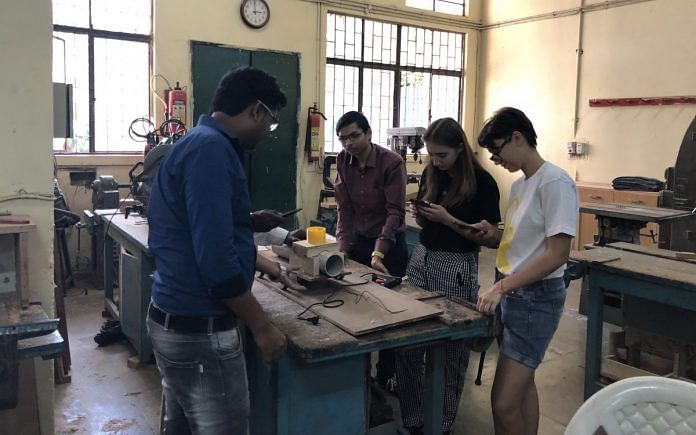10 Russian students are in India to work with local students on projects like space tech & clean energy. These will be presented to Putin & Modi on 5 October.
New Delhi: Ahead of Russian President Vladimir Putin’s visit, a group of 10 gifted children from the SIRIUS Creative School in Sochi are in India for a five-day cultural and intellectual exchange camp with their local counterparts, called the ATL Boot Camp.
Four girls and six boys are representing India, while seven girls and three boys are visiting from Russia. They represent government and private schools in both countries.
The camp is being supported by IIT Delhi’s Department of Design, and organised by Atal Innovation Mission (AIM), a project under the NITI Aayog. ATL (Atal Tinkering Labs) come under the AIM, and aim to promote entrepreneurship and innovation in India.
At the end of the five-day workshop, five teams of students will present their models at Putin and Prime Minister Narendra Modi’s meeting on 5 October.
Each of the five teams consists of two Russian and two Indian students, supported by two Indian mentors. There are two Russian mentors assisting all the teams as well.
The students are broadly working on projects related to space technology, agricultural innovation, clean energy, smart mobility and healthcare.
Also read: As New Delhi readies for Putin visit, Russia quizzes India on secret military pact with US
Rigorous selection process
The idea for the initiative took shape when Modi visited Russia in May. The students participating in the camp have been chosen after a rigorous selection process in both countries.
“We received around 6,000 applications for a tinkering marathon. We announced the top 30 out of these in early 2018,” said Dr Ayesha Chaudhary, member of NITI Aayog and one of the main organisers of the event.
“Out of these, we chose the top five teams to participate in the camp.”
Christina Raguzora, a mentor from SIRIUS, said: “There was a three-step process of selection that we followed. After Skype interviews with the short-listed 30, we decided on the 10 students who would be attending this camp.”
Chaudhary said some of the Russian students have even worked on projects about advanced cancer research.
The Indian students are not lagging behind; they have won various national awards and represented the country internationally.
“My team of students has been to Dubai for an international competition,” said Dr Dhannanjay Pandey, who is supervising a team from a government school in Bilaspur, Chhattisgarh.
Tech bridges language gap
The experience, aided by a translator at times, has been very interesting for most of the participants. From mentors to students, everyone feels they have learned new things.
Although the students initially struggled to understand each other, technical terms seem to have bridged the language gap.
“We speak different English,” exclaimed Alise Dolvneva, one of the Russian students.
Ivan Buzdalin added: “We had many agreements and disagreements, but eventually, when we talked in technical terms, we could communicate more easily.”
According to Rohith V., a school ATL coordinator from Karnataka, the students also come with very different skill sets. “While our students understand basics better, they seem to grasp macro concepts very well. They can easily understand robotronics, but struggle with some machines,” he said.
Asked about the kind of projects they are working on, Mannat Mehta from the Rainbow International School in Kangra, Himachal Pradesh, one of the youngest at the camp at 15 years of age, said her team’s focus was on the safety of two-wheeler riders.
“We are working on a helmet detector. That way, unless you’re wearing a helmet, you can’t drive,” she said.
Also read: Modi govt set to shake off Ambani-Rafale shadow with a little help from Putin
AIM and ATL
A flagship project of the Prime Minister’s Office, AIM began in 2015. It has since set up nearly 5,000 ATLs across the country. Of these, around 2,000 are already functional said Chaudhary.
These labs provide the latest technological equipment, from internet of things to robotics. Each school is provided Rs 10 lakh initially to set up the lab, followed by Rs 2 lakh each year for five years.
The idea behind AIM is to instill a sense of entrepreneurship in students, who normally do not have access to a supportive apparatus for the same.
“AIM wants to encourage a sense of curiosity, followed by innovation. There are so many problems we face on a daily basis, AIM wants students to harness their energy to solve these,” said Chaudhary.






